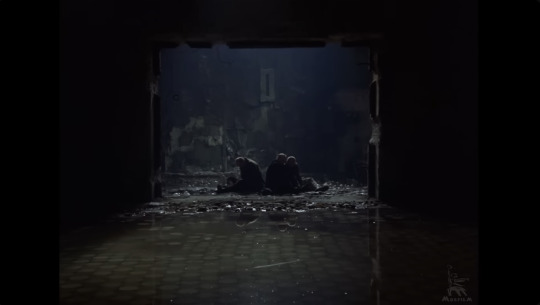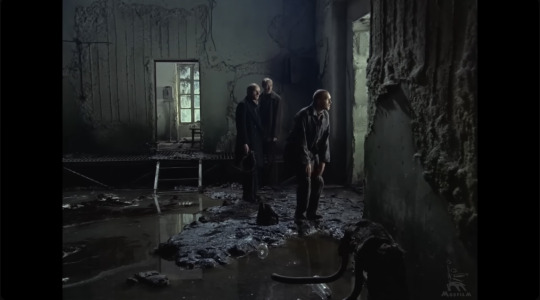Text
Tarkovsky's Influence
Andrei Tarkovsky secured his place in film making history not by being a director who followed the “rules” set by those who came before him, but by taking the great works that preceded him and innovating with what he found useful. Works such as Stalker do not have pacing that lines up with the average popular movie these days; they intentionally diverge from such frames, and this is how his style has remained notable decades after his death. As will always happen, the film makers who came after him have taken his innovation and incorporated it into their own work. Though his films inspired the work of many, two recent directors stand out with how they carried on his legacy. Christopher Nolan and Lars Von Trier are two famous contemporary directors who have found inspiration in the Russian director’s classics. Though the directors do not follow exactly in line with Tarkovsky’s genre choices, Nolan in particular springing for more in-the-face scenes of violence, it cannot be denied that they both at times have found influence by him, especially since both have named works of his as sources of creativity.
Christopher Nolan created one of the works likely to be a large part of his legacy in 2023 with Oppenheimer. The long movie follows one man, scientist J. Robert Oppenheimer, as he creates the atomic bomb and spends the rest of his life living with his accomplishment. This film is not one that would immediately be obvious as related to the works of Tarkovsky; everything feels a bit too “normal” for lack of a better word. However, Nolan himself named the film Mirror as one that he came to admire greatly as he was working on his own Interstellar. Nolan admired greatly how fascinating the visuals of Tarkovsky’s work were, and even when working on a far less abstract movie, Nolan wanted to ensure that his work has visual much the same in terms of value. Returning to Interstellar, it is one of perhaps innumerable pieces of science fiction that Tarkovsky helped inspire with 1972’s Solaris. Both films track humanity in space and both delve deep into theoretical actions that the characters could take as they explore scenarios that the creators, or any human at large, would be unable to provide a solid answer for. The design of the various crafts and the ideas about human space exploration shown in Interstellar would certainly look different if not for Tarkovsky’s work.
Lars Von Trier’s filmography resembles Tarkovsky’s more closely than the previous director. Dealing with very deep mental topics, his movies, such as the famous Antichrist or Melancholia, use very grand and often distressing images to help examine the characters’ minds. Trier, who went so far as to call Tarkovsky “God” in an interview, is an explicit dedicated fan of the director and dedicated Antichrist to him personally. Both directors have touched on very raw subjects related to human emotion with their work, and though Von Trier has used much more intentionally shocking and taboo imagery in his work, the parallels are undeniable in what they are setting out to achieve.
Attached are images of space stations shown in Solaris and Interstellar along with clips of Von Trier speaking about Tarkovsky.


youtube
youtube
0 notes
Text
Stalker
One of Andrei Tarkovsky’s most notable works is his 1979 science fiction film Stalker. Far from other action-packed films of the genre, one of the first things that Stalker will make apparent to the audience is that it is a very slow movie, and it means to be that way. Set in a slightly alternate world to our own, it follows the journey of three men who journey to “The Zone”, an uninhabitable and mystical piece of land implied to be somewhere in the Soviet Union. They seek “The Room”, a place said to grant the deepest wish of those who enter it. Two men employ a stalker, a type of guide who specializes in traversing The Zone, and they set out on a quest to reach The Room.
The film opens with The Stalker at home with his wife and daughter. They live in very poor circumstances, with no place in the film ever looking stable. Against his wife’s protests, The Stalker meets with two men who wish to go into The Zone. Unnamed, they are known as The Writer and The Professor. They first must sneak past a large military force to get on the path to The Zone, which they do and soon are unhampered as they take a rail cart down a long way of tracks into the zone. The audience knows when they enter the zone, as the film goes from drained of color to fully alive with it once they make it. The Stalker speaks very seriously about The Zone, to the point where it seems The Zone is not a mere place and has a mind of its own. Though not assailed by humans, the men are convinced by The Stalker that The Zone has obstacles in place that he negates with his own knowledge. The three men make it to The Room after a long journey, during which they open up about their wishes. The Professor wants accolades for studying and reporting on The Zone, while The Writer simply wants to overcome writer’s block for his own work. However, The Professor produces a bomb from his bag and reveals that he is really there to destroy The Room, ensuring that more vicious men than himself cannot use it to realize their wishes. He is prevented from doing this by the others, and soon they all sit down in exhaustion. The Stalker had told a story about how another stalker, named Porcupine, had gotten a wish of great wealth granted by the room but still went on to commit suicide. The Writer pieces together the rest of the story: Porcupine had killed his own brother, along with him on the journey, during a part of The Zone that required somebody to die for the others to continue. Porcupine intended to use The Room to bring his brother back, but The Room knew that he wished for money more truly than that and gave him the wealth. None of the three men end up entering The Room, and The Professor also gives up on his bomb plan. They return to their homes, where The Stalker laments that people these days do not have enough belief to use The Room. As the film ends, The Stalker’s daughter appears to move objects with her mind.
The entire film is paced very slowly, and its style is very obvious. The film would not be what it is without the minutes-long stable takes of scenery, or the lack of loud action. The way it is makes it possible for the audience to truly feel familiar with The Zone. The Zone looks like it has been destroyed, either through violence or through decades, or centuries, long decay, but the truth is not actually given. The audience instead gets to look at it endlessly, allowing them to come up with their own theories. The most important takes in my opinion came after the scene with the bomb. The men sit in contemplation, as does the viewer. The characters have all just let out a good deal of emotion as they argued about what to do and now they let it hang in the air around them. It would not be as effective to film the scene in a faster way, as it would threaten to take the punch out of it. The Professor sits with the failure of his mission, The Writer sits with the realization of what this place is really like, and The Stalker sits with criticism of his livelihood that The Writer had just lobbed at him.
Attached are frames from the film that I found to be important, as well as a scene directly before the scene I just highlighted. I thought these images above others helped to show how the men feel in The Zone, being in a very unfamiliar area and overwhelmed by that it contains.



youtube
0 notes
Text
Entry 1
Andrey Arsenyevich Tarkovsky, 1932-1986, is one of the most famous Russian directors of all time. He grew up the son of another artist, with his father Arseny being a poet by trade. Known for his unique and at times experimental work, especially with regard to the structure of his films’ plots, he would put out seven full length films during his career, active from 1962 to 1986.
I have only seen one film at this time by the director, that being his famous Stalker. It was a much slower film in pace than I was used to, but I was very quickly drawn in by how real the environment felt and a deep sense of curiosity about the world he had created. Stalker is one of my favorite films across the medium, it has given one of the most distinct movie watching experiences I have ever had, and has given me a lot of interest in how Tarkovsky has created that work and others.
One of his hallmarks is the extremely long takes used for minutes at a time in his films, and overall his style would help the audience get a very deep feel for the setting, where a viewer can feel immersed in the sometimes fictional world. Tarkovsky graduated from the Soviet Union’s All-Union State Cinematography Institute in 1960 and would have a feature film out only two years later. 1962’s historical drama Ivan’s Childhood would put him on the map as a director and he would continue to work until his death, which would occur the same year that his last film was released. Some of his films, such as Solaris or Stalker, would be unique takes on science fiction. Stalker would be the fifth and last film he made in his native USSR, as conflicts with the censorship put in place by the government would lead him to continue his career in other places, passing away in Paris at only age 54, being buried close to the city as well. His semi-autobiographical film Mirror would be one of his most famous in the years following his life, serving as a very prominent example of the unique storytelling structures he frequently employed. Often utilizing the indescribable feeling of being in a dream, Tarkovsky showed this very clearly in Mirror’s fantastical sequences. Stalker would also live on, his fascinating post-apocalyptic environment of The Zone being presented in an almost interactive way to the audience through very long takes and a natural soundscape. Throughout his career, he would be inspired by grand paintings to present the audiences with very intentionally put together frames that they’d be able to view for a long time as the camera held still, not unlike the way someone would stand in front of art in a museum. He also turned to history, especially domestic history, for inspiration. Ivan’s Childhood would follow an orphaned Russian boy during World War Two and his subsequent Andrei Rublev was set in the filmmaker’s take on the European Middle Ages. He would not go unrecognized in his own time, his films garnering awards from Cannes and Venice film festivals. Other prestigious directors such as Sweden’s Ingmar Bergman would also praise his craft as they saw it release.
0 notes